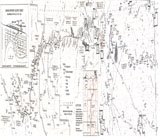The Canadian Northern Railway
This support however would be advanced only after sections of the railway line were completed. The bank would advance the money necessary to commence the project only if Mann entered into a partnership with one of his former contracting associates. William Mackenzie enthusiastically agreed.1 The partnership led to the building of an extensive prairie railway system which eventually developed into a transcontinental railway system. The Canadian Northern Railway was federally chartered in July 1899 with rights to build extensive new mileage.2
The partnership quickly developed a business strategy. They extended their railway lines into areas with high traffic generating potential. A commitment to low freight rates proved to be a significant cornerstone in the Mackenzie and Mann strategy. This helped them to gain support from prairie farmers and from local politicians particularly when they sought bond guarantees to expand the railway. In order to secure this position Mackenzie and Mann built to minimum standards to reduce expenses and to hasten the commencement of service. As markets became established and towns and villages grew up the railway lines were improved. Donald Mann described it as the “pioneering system of railroading.”3 They built a system of prairie main lines supported by a branch line network before completing a transcontinental system.4
The Canadian Northern Railway main line reached Edmonton late in 1905. Mackenzie and Mann originally intended to build to Edmonton via Prince Albert and Battleford. The Grand Trunk Pacific Railway intentions announced in 1901 pressed Mackenzie and Mann to build a more direct southerly route from Grandview, 25 miles west of Dauphin to Edmonton. This strategic move gave the Canadian Northern a hold on some of the potential market that might have gone to the Grand Trunk Pacific Railway (GTP). In July 1903 the federal Parliament approved the bond guarantees for the Grandview to Edmonton line and the extension of the more northerly line from Melfort to Prince Albert. Both were built to main line standards.5 Since the main line into Edmonton was built through completely new territory the promoters did negotiate higher freight rates than those in effect in Manitoba.6
As early as 1909 a major improvement program had commenced on the main line to Edmonton. The lighter track taken up from the main line became available for the branch line construction program. About this time Mackenzie and Mann abandoned the “pioneering system” because governments demanded a higher standard. In addition they were more optimistic about local development and they were able to raise money more easily. Most of the Alberta branch lines were therefore built to standards comparable with those of the main line.7
Sir Wilfred Laurier’s federal government provided assistance to railway main lines but postulated that local lines be financed by the provincial governments.8 In Alberta Mackenzie and Mann incorporated a number of branch lines each under a separate provincial statute quite apart from the Canadian Northern Railway Company. This approach gave the promoters more flexibility and removed the need to seek constant modification of the federal charter whenever additional branches were required.9 The Alberta government, anxious to open the province to settlement, guaranteed the bonds and the interest on the bonds for these railway companies. Once completed the operation and administration of these separately incorporated railways came under the auspices of the Canadian Northern Railway.
Competing interests for a line location from the GTP through the Yellowhead Pass and uncertainty about its outlet on the Pacific coast complicated the Canadian Northern’s decision to settle on a route west of Edmonton. Mackenzie and Mann steadfastly refused co-operation of any kind with the GTP on the Edmonton-Pacific coast section. Following considerable negotiation with the federal government the Yellowhead Pass route was finally approved. The federally chartered Canadian Northern Alberta Railway supported by federal bond guarantees provided Mackenzie and Mann with a means to extend their railway line west of Edmonton toward the Yellowhead Pass closely paralleling the GTP line and ultimately to a Pacific coast terminal at Vancouver.10 The last spike on the Canadian Northern Railway was driven without fanfare by William Mackenzie at Basque, B.C. on January 23, 1915.11
Notes | Bibliography | Abbreviations
1. T.H. Regehr, The Canadian Northern Railway: Pioneer Road of the Northern Prairies, 1895–1918 (Toronto: Macmillan of Canada, 1976), p. 40.2. Ibid., pp. 74–75.
3. Canadian Railway and Marine World, December 1908, p. 879.
4. Regehr, The Canadian Northern Railway, pp. 159–63.
5. Ibid., pp. 167–68.
6. Ibid., p. 164.
7. Ibid., p. 217.
8. Ibid., p. 198.
9. Ibid., p. 194.
10. Ibid., p. 289.
11. Ibid., p. 390.


